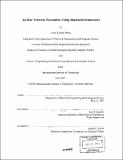| dc.contributor.advisor | Kai-Yeung Siu. | en_US |
| dc.contributor.author | Mehta, Amar Kailash, 1979- | en_US |
| dc.contributor.other | Massachusetts Institute of Technology. Dept. of Electrical Engineering and Computer Science. | en_US |
| dc.date.accessioned | 2005-08-23T21:20:32Z | |
| dc.date.available | 2005-08-23T21:20:32Z | |
| dc.date.copyright | 2001 | en_US |
| dc.date.issued | 2001 | en_US |
| dc.identifier.uri | http://hdl.handle.net/1721.1/8568 | |
| dc.description | Thesis (M.Eng. and S.B.)--Massachusetts Institute of Technology, Dept. of Electrical Engineering and Computer Science, 2001. | en_US |
| dc.description | Includes bibliographical references (leaf 80). | en_US |
| dc.description.statementofresponsibility | by Amar Kailash Mehta. | en_US |
| dc.format.extent | 80 leaves | en_US |
| dc.format.extent | 5413879 bytes | |
| dc.format.extent | 5413640 bytes | |
| dc.format.mimetype | application/pdf | |
| dc.format.mimetype | application/pdf | |
| dc.language.iso | eng | en_US |
| dc.publisher | Massachusetts Institute of Technology | en_US |
| dc.rights | M.I.T. theses are protected by copyright. They may be viewed from this source for any purpose, but reproduction or distribution in any format is prohibited without written permission. See provided URL for inquiries about permission. | en_US |
| dc.rights.uri | http://dspace.mit.edu/handle/1721.1/7582 | |
| dc.subject | Electrical Engineering and Computer Science. | en_US |
| dc.title | Ad hoc network formation using Bluetooth scatternets | en_US |
| dc.type | Thesis | en_US |
| dc.description.degree | M.Eng.and S.B. | en_US |
| dc.contributor.department | Massachusetts Institute of Technology. Department of Electrical Engineering and Computer Science | |
| dc.identifier.oclc | 49211873 | en_US |
| dc.audience.educationlevel | This thesis presents and evaluates an ad hoc network formation algorithm. The algorithm is designed to function under the specifications of Bluetooth, a short-range radio technology with a host of wireless applications. Since Bluetooth is a fairly new technology, the current specification does not explicitly detail how Bluetooth-enabled devices discover one another and optimally group together, forming a scatternet. Properly formed scatternets allow communication between any two Bluetooth-enabled devices. The algorithm presented is evaluated on several performance metrics based on both the final scatternet configuration as well as the time and packet complexity in forming the scatternet. Lower-level link control protocols in conjunction with the higher-level scatternet formation algorithm are simulated to yield an accurate assessment. The simulation results validate existing theoretical bounds. | en_US |
